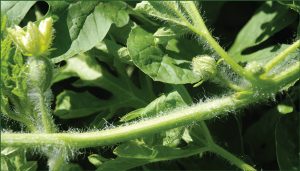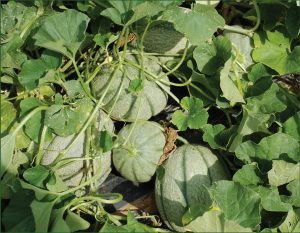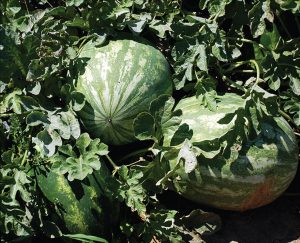
Dry or Bulk Fertilizer: Apply approximately 50% of your expected nutrient requirements as granular materials prior to planting. By applying only, a portion of the necessary nutrients before the crop gets going you are doing a lot to prevent nutrient leaching and runoff while still providing a good nutritional start to your season. Knott’s Handbook for Vegetable Growers recommends: 75-100 units of N, 100-150 units P2O5, and 200 units K2O for the entire season. Sufficient magnesium in balance with calcium is critical in growing great melons. If your pH is above 6.8, use gypsum (CaSO4) as your calcium source preplant. Epsom Salts (MgSO4) is an excellent source of Mg prior to planting.
It should be noted that this program is presented as a guideline only based upon research and the experiences with a number of growers. With the wide variances possible from both soil types and environmental conditions present during any particular season, your actual recommendation can vary from what is presented. It is always advisable to discuss actual management practices with your local ISP specialist.

Transplant Solution: Transplant mix should contain: 8 pounds 10-45-10; 24 fluid ounces PhytoGro Xtra; and 16 fluid ounces MetaboliK SB per 100 gallons of solution. Water all newly planted melons in thoroughly with this solution.
Direct seeding: 12 – 15 pounds 10-45-10, 24 fluid ounces MetaboliK SB, and 12 ounces MetaboliK HV-1. Apply either through drip lines; or band spray over the planting bed prior to formation, mixing nutrient throughout the bed.
NOTE, First 30 Days: Our objective is to build an aggressive frame in order to increase potential number of fruiting sites and forms at first fruiting. (If it is thought that one needs to push the frame, it can be beneficial to apply 28-16-7.) If plant frame shows excessive vegetative growth, apply 0-36-30.

The more aggressive growers are always observing all aspects of plant growth, vegetative development, numbers of fruit set, and of course any outbreak of pests or disease. Although this provides valuable data, it is recommended that tissue tests be taken to monitor actual nutrient uptake and potential deficiencies. The first tissue sample should be taken as the vines begin to runner with at least 5 leaves, and again as the first fruits are setting. Use the following as targets from your lab results: B – 4.5-5%; P – .8%; K – 5%; Ca – 3%; Mg – .8-1%; S – 1%; B – 50ppm; Zn – 150ppm; Mn – 200ppm; Fe – 50-300ppm; and Cu – 30ppm. Although it is usually a separate test, silicon should be at 3,500ppm.
Male to Female Ratio’s: Most initial blooms are male, but within a week following first flower, female buds should be initiating. If females are not forming, it can be beneficial to apply 0-36-30, 10-20-20, or 9-14-24. Once females initiate, the ratios of female to male buds are:
Cantaloupes – a female every four or five nodes (or one per four or five male blooms).
Watermelons – a female every eight to nine nodes ( or one per eight or nine male blooms).
Begin feeding one to two weeks following transplanting, or if direct seeded the plants have emerged and have three to four leaves. All of the information in the table below are shown as “per week” application rates.
|
ISP Soluble Plant Foods |
|||
|
Week |
Per Acre |
Per 1,000 feet of Row |
Other Notes, micronutrients, calcium, magnesium |
|
1-2 |
15 pounds 10-20-20, & 6 pounds 28-16-7 |
2 pounds 10-20-20, & 1 pound 28-16-7 |
Include SiGuard at 1 tsp. (5ml) plus MetaboliK HV-1 at 1 tsp. (5ml) per gallon either every 10 days or with crop protection sprays. |
|
3 |
15 pounds 10-20-20, & 6 pounds 28-16-7 |
2 pounds 10-20-20, & 1 pound 28-16-7 |
Tissue test as plants should be beginning to runner. If P is low, add 5 pounds 10-45-10 per acre per week to your nutrient programs. |
|
4 |
15 pounds 10-20-20, & 6 pounds 28-16-7 |
2 pounds 10-20-20, & 1 pound 28-16-7 |
Last opportunity to clean up weeds, as vines should be starting to run aggressively. |
|
5 |
15 pounds 10-20-20, & 25 pounds 4-18-38, & 8 ounces SiMag58 |
2 pounds 10-20-20, & 3.5 pounds 4-18-38, 1.25oz (35gm) SiMag58 |
|
|
6 |
17.5 pounds 10-20-20, & 25 pounds 4-18-38, & 8 ounces SiMag58 |
2.5 pounds 10-20-20, & 3.5 pounds 4-18-38, & 1.25oz (35gm) SiMag58 |
Tissue tests as plansta re setting first fruit. Switch from SiGuard to SiMag58 foliarly at 1tsp (5ml) per gal. every 5-7 days with other foliar materials. Continue MetaboliK HV-1 at 1tsp. per gallon at 7-10 day intervals. |
|
7 |
10 pounds 10-20-20, & 40 pounds 4-18-38, & 8 ounces SiMag58 |
1.5 pounds 10-20-20, & 5.5 pounds 4-18-38, & 1.25oz (35gm) SiMag58 |
Apply 2-4 pounds 4-18-38 foliarly. |
|
8 |
40 pounds 4-18-38, & 8 ounces SiMag58 |
5.5 pounds 4-18-38, & 1.25oz(35gm) SiMag58 |
Apply 2-4 pounds 4-18-38 foliarly. |
|
9 |
40 pounds 4-18-38 |
5.5 pounds 4-18-38 |
Continued fertigation after this point depends upon status of the field. Scout often for spider mites. |
|
10 to end |
25 pounds 4-18-38 |
3.5 pounds 4-18-38 |
|
 NOTE: the information in the table is designed for most melons with a maturity of 80 to 95 days, with average weather. Prolonged cool, cloudy periods will add days to this schedule, and extreme heat can shorten the schedule. Tissue testing at the two critical points listed above will greatly improve opportunities for a successful crop. Tissue test as the vines are beginning to runner with at least five leaves, and again as the first fruits are beginning to set.
NOTE: the information in the table is designed for most melons with a maturity of 80 to 95 days, with average weather. Prolonged cool, cloudy periods will add days to this schedule, and extreme heat can shorten the schedule. Tissue testing at the two critical points listed above will greatly improve opportunities for a successful crop. Tissue test as the vines are beginning to runner with at least five leaves, and again as the first fruits are beginning to set.
Apply MetaCal, or CalStore through the fertigation system weekly when not applying any P containing nutrients. Fill irrigation lines with water, inject CalStore or MetaCal, then flush lines with clear water. This will ensure that no clogging or precipitates are formed and that your developing fruit get plenty of calcium in balance with magnesium.
Foliar Applications: Foliarly applied nutrient (K, Ca and Mg) will greatly assist growers in maintaining sufficient amounts of these nutrients when coupled with a proper fertigation program, especially at key stress points. Examples are fruit set and/or maintaining vegetative growth with a heavy fruit load. Include ISP Plant Food and SiMag58 at 1-2 tsp each per gallon of foliar solution. Spray weekly with any foliar applications for pest management. Calcium supplements CalStore and MetaCal can be applied foliarly with pest management materials, but not with 4-18-38 in order to avoid any reactions with phosphorous (P).
